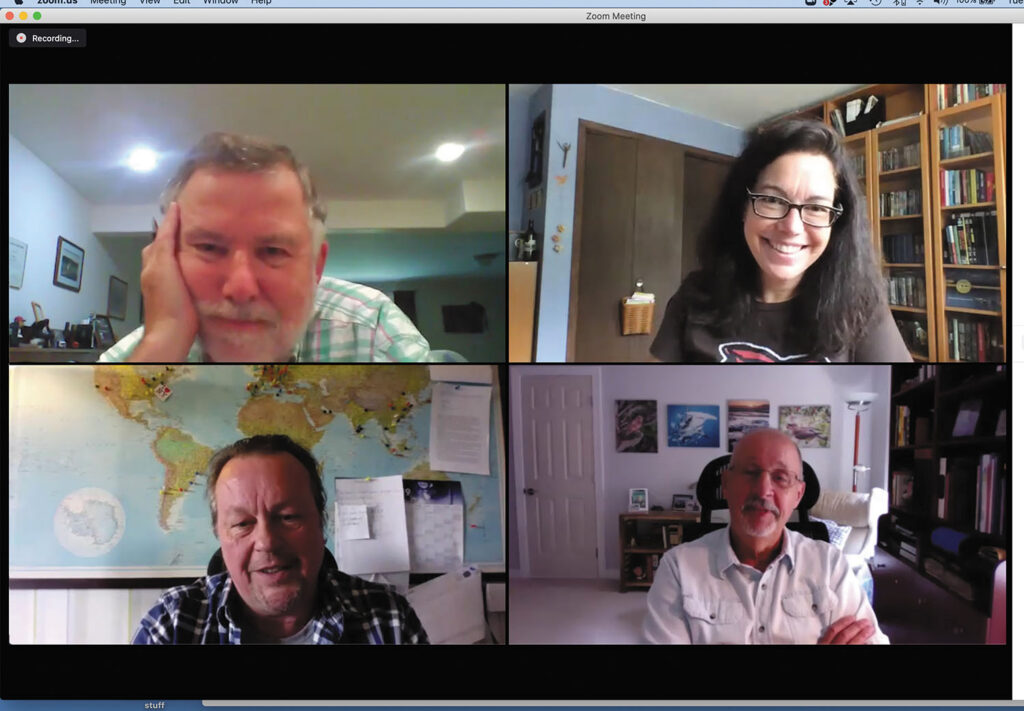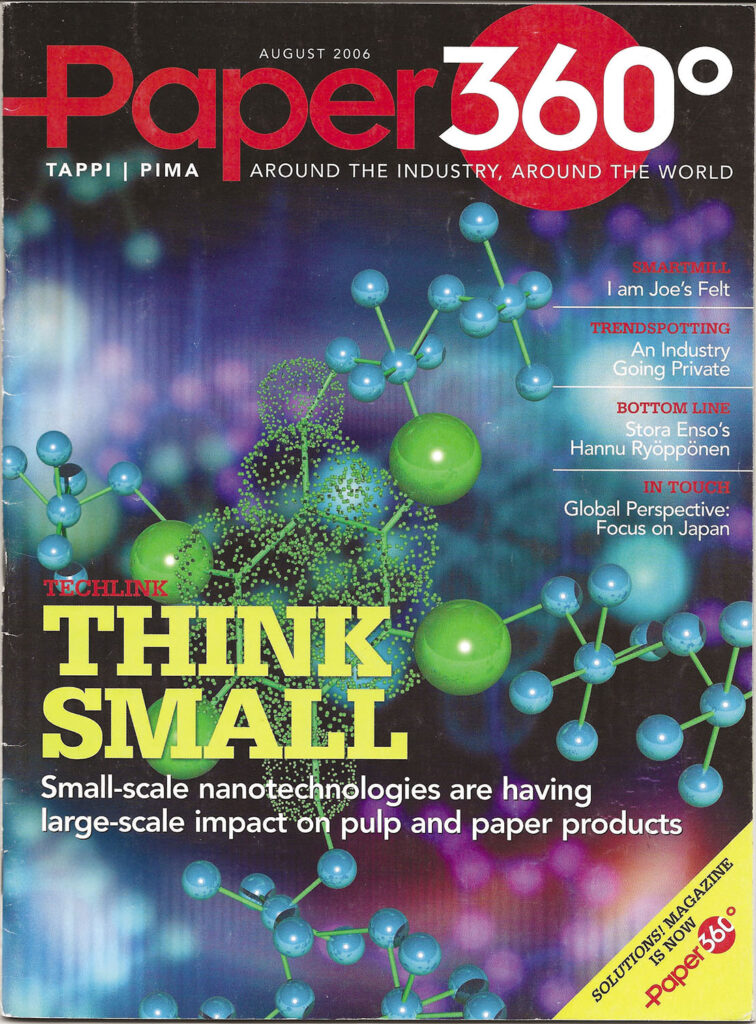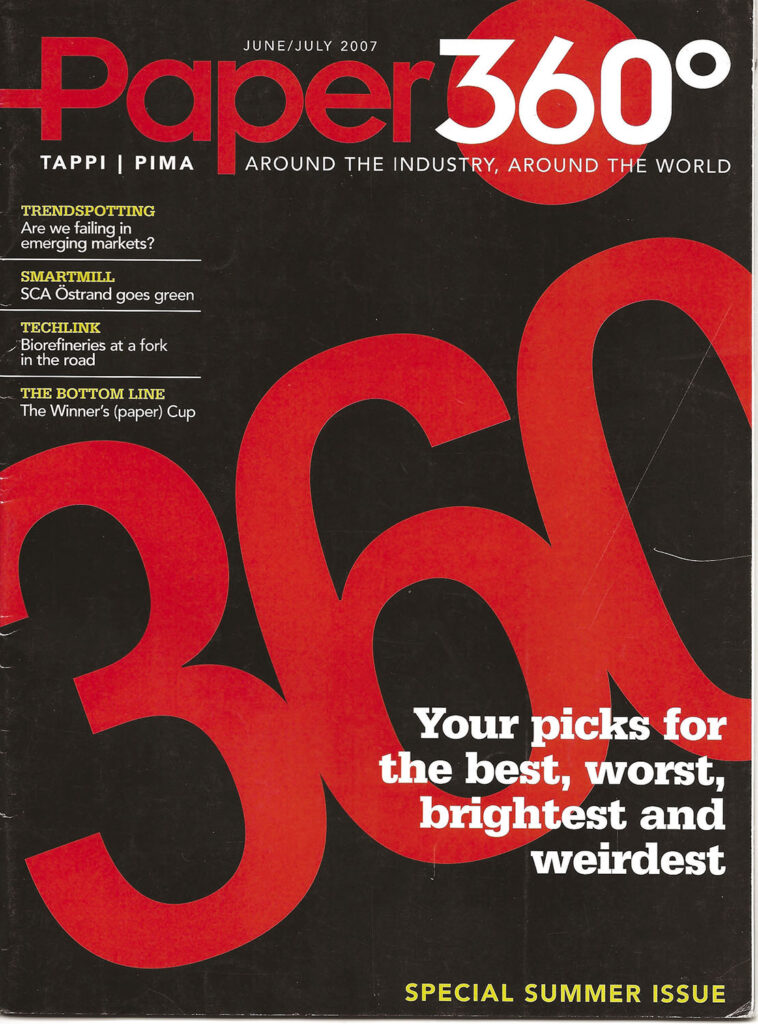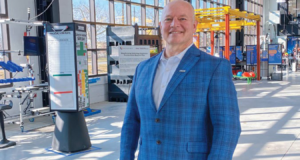JAN BOTTIGLIERI, GLENN OSTLE, GRAEME RODDEN, AND MARK RUSHTON
Since Paper360°’s first issue in 2006, our industry has evolved in exciting ways. At 100 issues and counting, this magazine has delivered insight into those changes to desktops and laptops around the world. We’ve made predictions and forecasts both accurate and not so much (a 2007 reader survey gave Barack Obama only a 4 percent chance of being the next US president.) We’ve fielded stories from every continent except Antarctica (where currently there are no paper mills, though climate change may someday rectify that.)

To kick off this 100th Issue Celebration, we’re pulling back the curtain on a recent conversation between your intrepid editorial team: Editorial Director Jan Bottiglieri, Senior Editors Graeme Rodden and Mark Rushton, and Editor Emeritus Glenn Ostle. Then you’ll find reader perspectives gathered from the TAPPI Connect online platform, where we invited pulp, paper, and packaging professionals to share their thoughts on industry change in three critical areas. We’d love to have you join the conversation—readers are invited to search “Paper360° Readers 100” at TAPPI Connect and add their comments.
Kudos to every reader for being the most important part of Paper360°. We are so glad to have weathered these changes with you.
EDITOR PERSPECTIVES ON 100 ISSUES
JB: Okay, so let’s… conversate! One thing that’s really changed since Paper360° started is the landscape for print publications covering the pulp and paper industry. We all have roots in different publications. I started with PIMA Magazine in ’87, then Papermaker, then I joined TAPPI and worked on Solutions!, then TAPPI Journal, and now Paper360°. Graeme and Mark, where are your roots?
GR: I started in 1980 with Pulp and Paper Canada—I was with them for 21 years. Then, I was editorial director for Paperloop (now FastmarketsRISI) and editor of PPI in Brussels. Then, I was executive editor of PPI and editor of Pulp & Paper before coming to TAPPI in 2015 when PPI and Paper360° merged.
MR: I actually started as a printer, but I always wanted to write; the opportunity came in 2000 when I landed at Whitmar Publications, writing and traveling for Paper Europe. I soon realized this is a fantastic industry to be in. I then went to PPI and started organizing events for RISI; now here I am.
GO: It’s been unbelievable. I started with Paper360°’s first issue in August, 2006—Jan, it’s ironic that you would write the first feature in the first issue, then end up as editor of the magazine years later! One person I’d like to throw in the mix here is Ken Patrick with TAPPI, may he rest in peace. We all knew him a helluva long time, and he contributed much to many publications.
That beginning was so long ago; we started planning in 2005, when TAPPI and PIMA were on two sides of the spectrum, just coming together. I think one of the highlights for the magazine was merging PPI and Paper360° at the end of 2015, right before I left.
JB: I’m glad we’re still putting out a print magazine. Our readers really value print; it’s an endorsement of what they do as papermakers, even while the industry keeps changing.
MR: Absolutely. Though all of the M&As among suppliers—our advertisers—has made it difficult.
GR: And the recession of 2008, 2009 really knocked down graphic papers. Of course, tissue is still strong.
JB: I think that shift—toward tissue and packaging—puts us in a better spot as our industry deals with the coronavirus pandemic.
MR: Even pre-COVID, there was a new wave of environmental understanding about how much better renewable packaging is. Young people now see us as a green industry, compared to the devastating effects that plastics are having on our oceans.
GO: I’m a diver, and we see plastics in the ocean everywhere. Microplastics and single-use plastics are especially bad. It’s a serious issue, to see these pristine parts of the world polluted. The paper industry has an important role in helping fix that.
JB: What other big changes have you guys seen? What do you see ahead?
GR: Environmentally, the growing awareness of water issues. Plus, we’ve got all these bioproducts coming on; companies will be finding new uses for our raw material.
MR: Look at companies like Södra Cell—they’re doing so much with added-value side streams. They’re using lignin to create biomethanol, which is fantastic. There are lots of others as well. Metsa Group’s Äänekoski Bioproduct Mill, for instance, is now making 20 percent of its revenue from areas other than pulp.
GR: Another technical advance is composites: paper plus plastics, latex, and more.
JB: Yeah, look at that first Paper360° cover article on nanotech; it was mostly about the research. Now, we’re finally beginning to reach commercialization, with nanocellulose technologies that enable those side streams and composites.
MR: Another big issue is attracting young people to our industry. I think that’s going to go hand-in-hand with the digital revolution taking place. We’re finally learning what to do with all our data; it’s exciting, and uses all sorts of new tech. We’re using AI goggles for maintenance, viewing the machine in 3D…
JB: …we’ve got digital twins, we’re using drones—it’s definitely more technologically engaging for young professionals.
GR: A hot topic for YPs is the work-life balance, and the use of technology is helping manage that. Taking everything together over the past 15 years, the changes seem revolutionary; but year-to-year, it seems evolutionary. The paper machine, dryer, winder—they still look like they always did, you just don’t see any people. The real revolution has been in automation technology.
GO: I’ve loved looking back at the last 100 issues and seeing what was top-of-mind then versus now. It’s been great seeing all of you guys again—I could sit and talk to you all day. Here’s to the next 100!
Editors’ note: Access more than 10 years of Paper360° archives at https://paper360.tappi.org.
READER PERSPECTIVES ON CHANGE
Over the past 10-15 years, what has been the most exciting technical development in pulp, paper, or packaging?
A technical advancement has occurred in the use of curtain coaters in the paperboard industry. I am hoping this will give enhanced sheet properties over other style coaters, as we are in the process of moving in that direction. We have seen several mills move in this direction and for the product we make, it has shown to be the best option.
—Barbara Russell, Republic Paperboard

The most exciting technical development in my area has been the invention of a variable profile height slotted basket. The profile of a slotted screen basket directly impacts capacity and efficiency. The lower the profile, the lower the capacity but the higher the efficiency. The converse is true as well.
Andritz, my former employer, developed a screen basket that has a variable profile height (lower at the feed end, higher at the reject end), but with a constant screening slot width. That means that the basket, all other things being equal, is able to achieve that elusive balance between capacity, efficiency, and runnability. This development has really changed the landscape in fine slotted screening.
—Jonathan Kerr, Process Training Consultants Inc.
Since 2000, I’ve seen few really new products and few “revolutionary” processes like twin wire or low solids cooking; yet there has been impressive continuous improvement. Nanocellulose has advanced, but there is no large-scale commercial facility yet. The high-energy recovery boiler was also developed earlier, but has now been replicated a dozen times; it can make most mills power independent.
The biggest change may be the continuous replication of exceedingly low-cost hardwood pulp mills in the tropics and subtropics that have very uniform fiber quality. It’s likely that there will never be another hardwood pulp mill built in North America.
—Benjamin Thorp, Bio-renewable Deployment Consortium
I think it’s been the development of highly accurate, portable, coordinate measuring machines including laser trackers, laser scanners, and portable measuring arms. The laser tracker in particular has dramatically changed the way precision alignment service engineers gather dimensional measurement data in paper mills. Laser trackers are much faster than traditional methods for inspecting paper machine components, plus they can capture thousands of data points in 3-dimensional space. With the use of associated metrology software, service engineers can not only inspect for the level and square positions of each roll or component, they can quickly generate 3D computer models showing roll diameter, roll geometry, and component locations.
— Myron Smith, OASIS
The use of computers, the data they generate, and the capabilities to store and process that data has led to multiple applications, all working toward enhancing the efficiency of production processes. These advancements have created bigger, faster, more flexible machines to deal with a wider breadth of grades.

Meanwhile, digital technologies are driving the way to more efficient, data-driven mills. Industry 4.0 or Smart Manufacturing is on the lips of all executives and managers at the plant level. The advance of digital technologies comes with the fear that technology will take over the operators; yet, just as digital animation revolutionized the way animated movies are produced but didn’t get rid of animators, the creativity and ingenuity of human talent is irreplaceable at the mills.
The question remains, how to organize people and processes to adopt the different digital technology options in a meaningful way. The short answer is—it depends. To discuss these important points, and to collaborate with industry experts in this field, join us on the TAPPI/PIMA IT Committee!
—Mariana Sandin, OSISoft & Bob White, Pulmac Systems
Over the past 10-15 years, what has been the biggest business change (leadership, markets, etc.) in these industries?
China has been a great disrupter of the global pulp and paper market. It has turned into the largest consumer of paper, befitting its position as the world’s second-largest economy. What is more surprising is that China is now the largest producer of paper and runs a trade surplus despite a massive shortfall of domestic fiber resources. The rapid development of the Chinese paper industry created a giant sucking sound of fiber from all parts of the world, both virgin and recycled. Recovered paper prices skyrocketed as Chinese papermakers scoured the world for fiber to feed their new machines. Business models based on this dynamic were turned on their heads when the Chinese government stopped the importation of solid waste, including recovered paper, and the Chinese economy slowed sharply when the US government ignited a trade war followed by the COVID-19 outbreak.
Another great disruptor has been the substitution of electronic communication for printed. Newsprint has been hardest hit; coated papers and uncoated mechanical papers are following close behind. Uncoated woodfree papers have been more resilient, but are now being hit hard by closures of offices and schools associated with the coronavirus pandemic.
Luckily, there is also good news in the paper industry. Tissue usage continues to expand at or above the pace of the general economy and is being helped by the pandemic. E-commerce is supporting faster growth in containerboard usage and is also being helped by the coronavirus due to the closures of brick and mortar stores. More countries are enacting legislation to reduce the use of plastics; paper or other products using wood fiber are the likely alternatives, and world paper consumption is still increasing.
The last 15 years have shown that flexibility is key to not only surviving, but prospering in the global pulp and paper industry.
— Rod Young, Chief Economic Advisor, Fastmarkets RISI
The use of different media has skyrocketed. With different social media venues, video conferencing, etc., there are so many ways to communicate that it can sometimes be overwhelming. You live in your “office” as your phone or even watch can alert you to emails, your health status, and where your kids or spouse are. It is almost impossible not to check status reports when you are on vacation. Yet even with all these media, communications within the mills can still be a challenge.
—Barbara Russell, Republic Paperboard
The rapid decline of printing paper markets has forced many corporate restructurings, mill closures, layoffs, etc. A direct consequence of the weakness in industry demand is the initiation of the producer-funded, USDA-sanctioned commodity checkoff program, the Paper & Packaging Board. This has achieved positive results in its campaigns to communicate the positive aspects of paper and packaging products.\
— Ron Brown, 50 Year TAPPI Member/Retired, MeadWestvaco
From a supplier perspective, there has been a dramatic shift not only in the grades our customers produce, but also in customer expectations. Fewer but larger corporations now rely heavily on suppliers to be the grade-specific process experts and not just machine builders. In today’s business environment, customers are relying on supplier knowledge to an even greater extent. Another big change is the integration of digitalization to enhance efficiency. Our customers have been fast to recognize the benefits of digital programs and platforms for automation and data collection.
Voith has seen a big increase in collaboration throughout our teams, both internationally and regionally. This has resulted in us streamlining our product portfolio and pulling our resources together to better meet customers’ changing needs. Collaboration is also extremely important for the industry as a whole, as many members of the workforce are nearing retirement. It’s a critical part of the knowledge transfer needed as the industry evolves.
—May Fursey, Voith Paper North America
Over the last 10 years, the most significant business change that I have witnessed—and been thankful to be a part of—is a change in who receives leadership training and other professional development opportunities. During my first few years out of college, I had little to no real management experience or learning; at that time, the focus was on developing those in roles two and three levels above mine. This paradigm has changed and now includes the entire organizational structure from top to bottom. Entry-level engineers and senior-level managers are now being brought into the same session to build on leadership skills and share individual perspectives. This change exposes team members to a wide range of viewpoints at all career levels and helps to develop trust and respect. This cohesion allows teams to be more creative, innovative, and agile as the industry changes to meet customer demands.
— Mike Subila, Domtar
Over the past 10-15 years, what has been the most important environmental advancement in these industries?
The largest change in the last decade has been the continued transformation of grade mix. Publication grade mills have vanished with an almost mind-numbing speed, and packaging mills have flourished. One of the most heartening adjuncts of this evolution has been the growing sophistication of those kraft mills. Our industry has always been a good environmental steward not just because that’s righteous, but because sustainability is a fundamental survival philosophy of any natural resource-based industry. Traditionally, mills have used water as if it were a limitless resource; this is no longer true.
There are two particularly notable areas that have proven themselves. First, hot water from pulp mills is used on paper machines to save water and energy. Second, white water is more commonly reused on paper machines to reduce water consumption, save fiber, and save energy. Many multi-million-dollar projects have been performed to implement these technologies. They are economically justifiable, but as importantly, they are the right thing to do. It is heartening to see paper companies doing the right thing, and it makes me proud.
—John Neun, P.E., CleanTech Partners
The paper industry has always been in the spotlight for environmental issues; however, it has faced all the challenges with vigor. There is never enough credit given to the improvements made because the problems are always remembered. With recycling efforts for fiber and water systems, the paper industry has jumped to meet the requirements. Groups like TAPPI, RPTA, and NCASI have pulled together experts and mill personnel to evaluate and develop alternatives and present information. Kudos should be given.
—Barbara Russell, Republic Paperboard
The pulp and paper industry is finally being (reluctantly) recognized as a sustainable industry. The glut of plastics in the oceans (almost entirely from third world countries without adequate waste management systems) was a driver. This will continue to cause a shift to paper and/or the development of biodegradable bio-plastics. There are now systems being deployed to convert pulp mill emissions into useful products. This can significantly reduce environmental footprint and can add revenue streams.
—Benjamin Thorp, Bio-renewable Deployment Consortium
The increased focus on water conservation and reuse in pulp and paper mills is the most important environmental advancement in the past 15 years. These initiatives began in the late 20th century and thus are not new in this century, but strong industry efforts led by AF&PA to reduce energy consumption in pulp and paper mills have continued to deliver good results over the past 10-15 years.
— Ron Brown, 50 Year TAPPI Member/Retired, MeadWestvaco
Fifteen years ago, the sustainability of the pulp and paper sector was controversial because papermaking was a capital-intensive process that required high consumption of cellulose, energy, and water. Today, companies are producing more with less, and paper is one of the most sustainable products, thanks to efforts in all three areas:
• The implementation of voluntary certification systems of sustainable forest management and chain-of-custody assure sustainable forest use globally and locally. The paper recycling rate has also steadily grown in this period, achieving new records: 72.5 percent in Europe; 68 percent in the US (the packaging recycling rate is even higher). And the development of the circular economy and biorefinery concepts has opened new markets for binding material, sugars, and fiber materials.
• Plans for reducing energy consumption have been implemented, with a continuous decrease of CO2 emissions. In Europe, absolute emissions fell by more than 27 percent since 2005.
• During this time the industry has further reduced its overall water consumption by increasing internal reuse, including the reuse of the reclaimed effluent. The next big step forward has been the jump to look for alternative water sources outside the fence—for example, the use of municipal reclaimed water. This has opened a world of new opportunities for water savings, representing a clear environmental advancement.
—Angeles Blanco Suarez, Complutense University, Madrid
_____________________________________________________________________________
Time Flies
Wow. It is true what they say: Time does certainly fly when you are having fun! Fourteen years has flown by since I started with TAPPI back in 2006—the same year that Paper360° published its first issue.

I can remember one of our board members that year handed me an early copy and said, “You need to get more pages in this magazine!” Mission accomplished. This publication now averages around 50 pages per issue.
Over the years, TAPPI’s editorial team has become a Who’s Who of World-Class Editors: Glenn Ostle, Ken Patrick, Jan Bottiglieri, Graeme Rodden, Mark Rushton, Tor Idhammar, and TAPPI Journal’s Monica Shaw. The metamorphosis of Paper360° has been great to witness; it has turned into the flagship publication for our global industry.
I cannot wait to read the 100th issue—and beyond.
— Larry Montague, TAPPI President & CEO
 Paper 360
Paper 360
